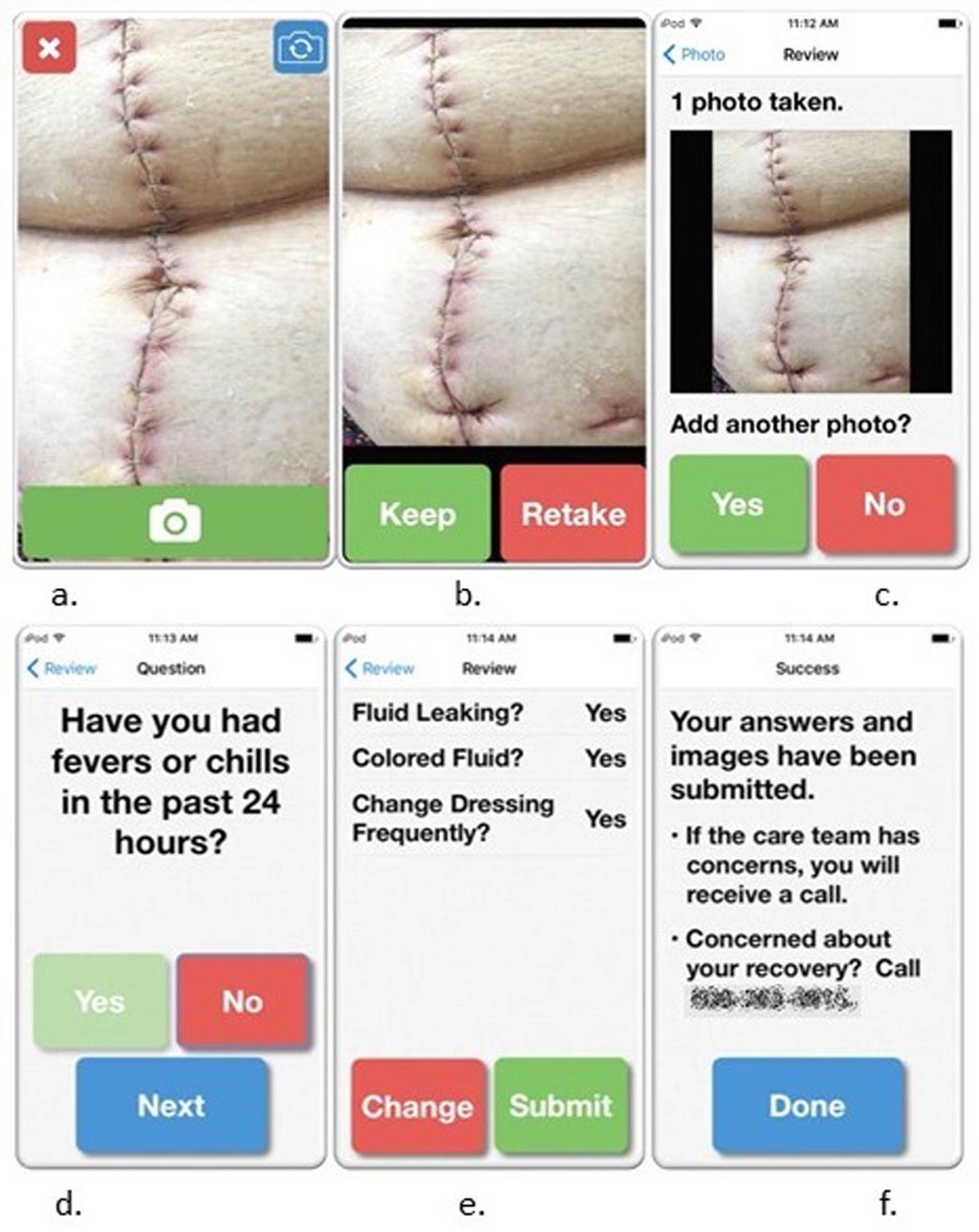Smartphone App Remotely Monitors Wound Healing
|
By HospiMedica International staff writers Posted on 14 Feb 2018 |

Image: A novel app helps patients and doctors monitor wound healing (Photo courtesy of WISC).
The healing of postoperative surgical wounds can be effectively monitored with a new smartphone app, according to a new study.
Developed at the University of Wisconsin (WISC; Madison, USA), WoundCheck is a remote wound monitoring protocol that uses smartphones to send images of a post-surgical wound, together with a short, patient-administered questionnaire to monitoring staff. To assess the mobile health application, 40 vascular surgery patients were trained to use it during their inpatient stay. After hospital discharge, they completed the app protocol daily for an additional two weeks. The inpatient team then reviewed submissions daily and contacted patients for concerning findings.
The results showed that 45% of participants submitted data every day for the two-week period, with an overall submission rate of 90.2%. The daily submissions were reviewed within an average of 9.7 hours of submission, with 91.9% of submissions reviewed within 24 hours. In all, the researchers detected seven wound complications, with one false negative. Participant and provider satisfaction was universally high. The study was published on January 19, 2018, in the Journal of the American College of Surgeons (JACS).
“We set out to come up with a protocol where patients could become active participants in their care and allow us to be in closer communication and monitor their wounds after they leave the hospital,” said lead author Rebecca Gunter, MD. “This approach allows us to intervene at an earlier time, rather than waiting for patients to come back in after the problem has already developed past the point of being able to manage it on an outpatient basis.”
Telemedicine offers the opportunity to leverage technology to remotely monitor recovery during the transitional period between hospital discharge and routine clinic follow-up. However, many existing telemedicine platforms are episodic, replacing routine follow-up, rather than equipped for continued monitoring; they include only low-risk patient populations and those who already have access to and comfort with the necessary technology, and transmit no visual information.
Related Links:
University of Wisconsin
Developed at the University of Wisconsin (WISC; Madison, USA), WoundCheck is a remote wound monitoring protocol that uses smartphones to send images of a post-surgical wound, together with a short, patient-administered questionnaire to monitoring staff. To assess the mobile health application, 40 vascular surgery patients were trained to use it during their inpatient stay. After hospital discharge, they completed the app protocol daily for an additional two weeks. The inpatient team then reviewed submissions daily and contacted patients for concerning findings.
The results showed that 45% of participants submitted data every day for the two-week period, with an overall submission rate of 90.2%. The daily submissions were reviewed within an average of 9.7 hours of submission, with 91.9% of submissions reviewed within 24 hours. In all, the researchers detected seven wound complications, with one false negative. Participant and provider satisfaction was universally high. The study was published on January 19, 2018, in the Journal of the American College of Surgeons (JACS).
“We set out to come up with a protocol where patients could become active participants in their care and allow us to be in closer communication and monitor their wounds after they leave the hospital,” said lead author Rebecca Gunter, MD. “This approach allows us to intervene at an earlier time, rather than waiting for patients to come back in after the problem has already developed past the point of being able to manage it on an outpatient basis.”
Telemedicine offers the opportunity to leverage technology to remotely monitor recovery during the transitional period between hospital discharge and routine clinic follow-up. However, many existing telemedicine platforms are episodic, replacing routine follow-up, rather than equipped for continued monitoring; they include only low-risk patient populations and those who already have access to and comfort with the necessary technology, and transmit no visual information.
Related Links:
University of Wisconsin
Latest Critical Care News
- Smart Nanomaterials Detect and Treat Traumatic Brain Injuries Simultaneously
- Earlier Blood Transfusion Could Reduce Heart Failure and Arrhythmia in Heart Disease Patients
- 'Smart' Shirt Detects Epileptic Seizures in Real Time
- Skin Patch Measures Effectiveness of Flu/COVID Vaccines in 10 Minutes
- Complete Revascularization Reduces Risk of Death from Cardiovascular Causes
- Tiny Fish-Inspired Robots Navigate Through Body to Deliver Targeted Drug Therapy
- Coronary Artery Stenosis Could Protect Patients from Pulmonary Embolism Effects
- Sweat-Powered Sticker Turns Drinking Cup into Health Sensor
- Skin-Mounted 3D Microfluidic Device Analyzes Sweat for Real-Time Health Assessment
- New Therapeutic Brain Implants to Eliminate Need for Surgery
- Stem Cell Patch Gently Heals Damaged Hearts Without Open-Heart Surgery
- Biomaterial Vaccines to Make Implanted Orthopedic Devices Safer
- Deep Learning Model Predicts Sepsis Patients Likely to Benefit from Steroid Treatment
- Programmable Drug-Delivery Patch Promotes Healing and Regrowth After Heart Attack
- Breakthrough Ultrasound Technology Measures Blood Viscosity in Real Time
- Magnetically Activated Microscopic Robotic Swarms Could Deliver Medicine Inside Body
Channels
Surgical Techniques
view channel
Automated System Enables Real-Time "Molecular Pathology" During Cancer Surgery
Accurately identifying tumor boundaries during radical prostatectomy remains one of the most persistent challenges in prostate cancer care. Positive surgical margins occur in up to 40% of cases, increasing... Read moreGroundbreaking Procedure Combines New Treatments for Liver Tumors
Removing or destroying liver tumors often requires patients to undergo two separate procedures, exposing them to multiple hospital stays, repeated anesthesia, and longer recovery times. Traditional approaches... Read morePatient Care
view channel
Revolutionary Automatic IV-Line Flushing Device to Enhance Infusion Care
More than 80% of in-hospital patients receive intravenous (IV) therapy. Every dose of IV medicine delivered in a small volume (<250 mL) infusion bag should be followed by subsequent flushing to ensure... Read more
VR Training Tool Combats Contamination of Portable Medical Equipment
Healthcare-associated infections (HAIs) impact one in every 31 patients, cause nearly 100,000 deaths each year, and cost USD 28.4 billion in direct medical expenses. Notably, up to 75% of these infections... Read more
Portable Biosensor Platform to Reduce Hospital-Acquired Infections
Approximately 4 million patients in the European Union acquire healthcare-associated infections (HAIs) or nosocomial infections each year, with around 37,000 deaths directly resulting from these infections,... Read moreFirst-Of-Its-Kind Portable Germicidal Light Technology Disinfects High-Touch Clinical Surfaces in Seconds
Reducing healthcare-acquired infections (HAIs) remains a pressing issue within global healthcare systems. In the United States alone, 1.7 million patients contract HAIs annually, leading to approximately... Read moreHealth IT
view channel
Printable Molecule-Selective Nanoparticles Enable Mass Production of Wearable Biosensors
The future of medicine is likely to focus on the personalization of healthcare—understanding exactly what an individual requires and delivering the appropriate combination of nutrients, metabolites, and... Read moreBusiness
view channel
Philips and Masimo Partner to Advance Patient Monitoring Measurement Technologies
Royal Philips (Amsterdam, Netherlands) and Masimo (Irvine, California, USA) have renewed their multi-year strategic collaboration, combining Philips’ expertise in patient monitoring with Masimo’s noninvasive... Read more
B. Braun Acquires Digital Microsurgery Company True Digital Surgery
The high-end microsurgery market in neurosurgery, spine, and ENT is undergoing a significant transformation. Traditional analog microscopes are giving way to digital exoscopes, which provide improved visualization,... Read more
CMEF 2025 to Promote Holistic and High-Quality Development of Medical and Health Industry
The 92nd China International Medical Equipment Fair (CMEF 2025) Autumn Exhibition is scheduled to be held from September 26 to 29 at the China Import and Export Fair Complex (Canton Fair Complex) in Guangzhou.... Read more













